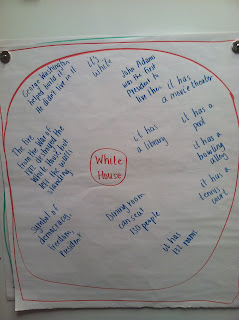So our first grade team took on a huge project and it went so well! American Symbols is one of our social studies standards and with the huge increase in informational text we decided to create a huge unit on it. Each teacher took a symbol - White House, Statue of Liberty, Washington Monument, American Flag, and Bald Eagle. Then, we came up with a PowerPoint, books to use, stations etc. My symbol was the White House - see my ideas below...
First, I started out by showing this fun video of a student interviewing President Obama. I started off by telling the kids that we had a mystery symbol today and they had to guess what it was. They loved the suspense and love the video. The video was about 10 minutes long so I picked out the appropriate parts that I thought they would enjoy.
Next, we watched a PowerPoint that I made on the White House. This PowerPoint focused on the main facts that I wanted my first graders to come away knowing. After the PowerPoint, we started a whole group circle map putting up details from the PowerPoint. Then, we read a nonfiction book about the White House and again added more facts.
See our White House Class Circle Map....
After working our class circle map, the kids made their own that they added to throughout the day. Then, it was time to move on to our White House Stations.
Station #1 - Informational Text
Students looked through a variety of White House books (different text levels) and added more facts to their circle maps.
Station #2 - Writing Activity
Students write a story about what life would be like if they lived in the White House.
Station #3 - Word Search
Students highlight the presidential words.
Station #4 - World Book Kids Article
Students read a White House article printed from World Book Kids online and highlighted key facts.
Station #5 - White House Virtual Tour
The White House has a great website with a virtual tour of the White House. The kids can see a map of the White House and see pictures and information on the various rooms. This is a kid favorite station!
After completing their circle maps, on day #2, the kids wrote a report on the White House using their circle map information.
Once we were all complete with our report on each symbol, students picked their favorite symbol to do a technology project on using the program "Frames." Our wonderful district Ed Tech is helping us out with this.
So, overall, this symbols project incorporates - reading standards, writing standards, social studies standards, listening and speaking standards, and technology standards. Love it!
Below are some student circle maps...























